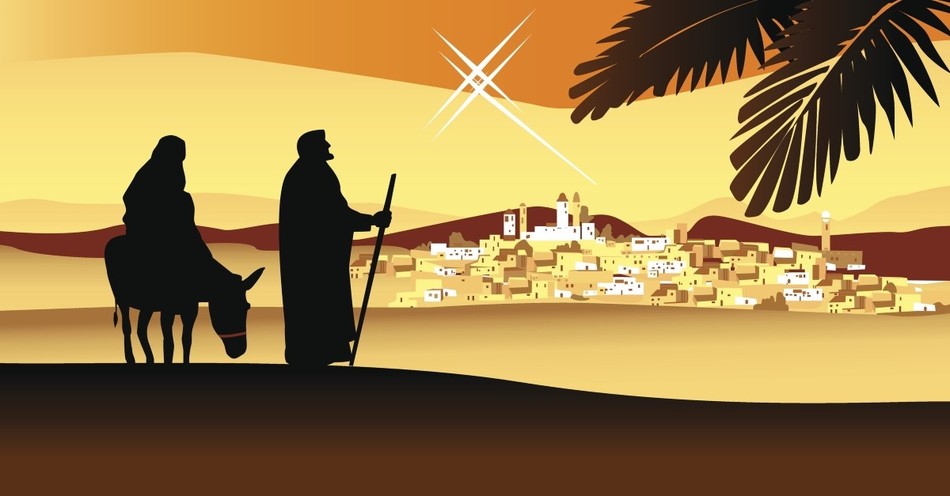During the Christmas season, many people will read the account of Jesus’ birth that starts with the iconic line, “In those days Caesar Augustus issued a decree that a census should be taken of the entire Roman world.” The Roman census is not only a key element of the Christmas story but also a key prophecy that God fulfilled through the Roman Census of Caesar Augustus.
But why did this Roman Census make Mary and Joseph go to Bethlehem? Why and when did the Roman census take place?
Here, we will explore history and scripture to understand this part of the Christmas story better.
Why Did the Roman Census Mean that Mary and Joseph Went to Bethlehem?
During a census, people returned to their hometowns to give an account of their property. Property at this time was considered to be all family members, including enslaved people or bondservants. BibleStudyTools.com contributor Annette Griffin says, “Roman law required people who lived in Judea and the surrounding area to return to their ancestral homeland for census registration.”
Since Joseph was of the family and line of David, as told to us in Matthew 1, Bethlehem was the registration place for people from the line of David.
Why Did Caesar Augustus Decree a Roman Census?
Caesar Augustus was the Emperor of the Roman Empire from 27 BC to 14 AD. During his reign, he wrote an autobiography known as the Res Gestae, or “The Acts of Augustus.” Christianity.com contributing writer Alyssa Roat notes, “Caesar Augustus was fond of censuses.” The Res Gestae provides references to several censuses taken during Augustus’ reign.
Censuses were organized regionally—many areas of the Roman Empire, including Judea, were considered city-states run by local governors. For example, Herod ran the city-state of Judea under loyalty to Rome. These city-states could make their own money and collect local taxes. So, people would go to the relevant location within their city-state to be counted in the census.
Censuses were important for several reasons. First, they gave Roman authorities up-to-date information about the number of subjects they had, which affected how much they could tax people, how many people they could conscript for military service, and where they needed to build more roads and infrastructure.
The tax element was especially important. As Christianity.com contributing writer Glory Dy explains, “Taxes helped keep the Roman army healthy, build roads, and finance army campaigns to keep conquering the world.”
Did the Roman Census Really Cover the Entire Roman World?
But what does Luke mean when he says there was a census “of the entire Roman world”? Currently, scholars debate whether these censuses were of the entire Roman Empire or only portions.
In John Nolland’s commentary on Luke, he states, “No single census embraced the whole Roman world, but each particular census was an expression of a consistent policy of the emperor for the whole of his empire.”
So, Luke may be using “of the entire Roman world” as an expression that his audience would have known as “a census representing the entire Roman world by association.”
What Year Did Ceasar Augustus Command the Roman Census?
Both scripture and archeology make it clear that Ceasar Augustus asked for several censuses during his reign as emperor.
The Romans were known for conducting a census approximately every seven years because maintaining an army to manage their empire was expensive. The remaining pieces of the Res Gestae state that Ceasar Augustus performed censuses in 28 B.C., 8 B.C., and 14 A.D. None of these align with the date of Jesus’ birth, which is assumed to be in late 5 or early 4 B.C.
But Luke 2:2 gives us another clue as to when this census occurred: “This was the first registration taken while Quirinius was governor of Syria.” Quirinius served as governor of Syria twice, once from 3-2 B.C. and again in 6-7 A.D.
Gleason Archer’s Encyclopedia of Bible Difficulties suggests that the word ‘first’ in Luke 2:2 means the Roman Census of 8 B.C. “would then be that the census that took Mary and Joseph to Bethlehem was the one that Augustus made before the one he took when Quirinius was governor of Syria (in A.D. 6).”
If Herod, who died in 4 BC, is such an integral part of the Christmas story from Matthew 2, how can we make sense of what year Augustus commanded the Roman Census that took Mary and Joseph to Bethlehem?
We need to remember that the idea that Mary and Joseph arrived in Bethlehem while Mary was in labor isn’t quite how the text describes the event. That Christmas image that Mary was days or hours away from delivery when they walked into Bethlehem’s gates is a dramatized idea based on our assumptions about Luke 2:6, but not a precise adaptation. The verse says, “while they were there [Bethlehem], the time came for the baby to be born.” So, we don’t know that Jesus was born on the night they arrived in Bethlehem. It may have been months before they reached Bethlehem.
Since archeology is always a developing field, there’s also the possibility that there was a regional census that we don’t know about yet—one that happened between the years we know from the existing fragments of Res Gestae.
Did Joseph Have Relatives Who Came Because of the Roman Census?
Unless Joseph was an only child in the last branch of the family, it is fair to assume other relatives of Joseph were also in Bethlehem. They might have been family members still living in the ancestral town or other family members in town for the Roman census.
Regardless, this means that the popular image of Mary and Joseph isolated with no one to help them in Bethlehem is unlikely. At the time of Jesus’ birth, hospitality was a key element of the culture. BibleArcheology.com says, “Even if he [Joseph] has never been there [Bethlehem] before he can appear suddenly at the home of a distant cousin, recite his genealogy, and he is among friends.” This makes an important point: the idea that Jesus was born in a random inn’s stable or cave is based on our assumptions, not Scripture or history’s details.
How does this information affect the verse, “There was no room at the inn” (Luke 2:7)? Well, first-century homes were different than how we imagine homes today. Generally, these homes had two rooms. One that served as the living area for the family with both a kitchen and a small area for keeping the family animals with a manger built into the floor. And a second room that was considered the sleeping quarters of the master or a guest room. The word “inn” seen in Luke 2:7 can also be translated as “guest room.” As Christianity.com contributor Betty Dunn explains, “Since there was “no room at the inn,” they likely stayed in a downstairs room that housed animals.”
How Did the Roman Census Fulfill Biblical Prophecy?
In Rome, Caesar Augustus probably did not know Jewish prophecy or that Joseph needed to get Mary to Bethlehem for the birth of Jesus. But his call for a Roman census would be a key factor in the Savior’s birth. God did know the when and how of Jesus’ birth. He even speaks of it in the Old Testament.
“But you, Bethlehem Ephrathah, are one of the smallest towns in Judah. But from you will come one who will rule Israel for me. He comes from very old times, from days long ago.” (Micah 5:2)
This verse is considered a key Old Testament Messianic prophecy. Micah’s prophecies were given during the pre-exile era of the southern kingdom of Judah. The northern kingdoms fell to the Assyrians in 722 BC, and Micah warned Judah that exile would be their fate if they continued to walk in disobedience to God. Micah prophesied about Judah’s coming exile and Israel’s ultimate restoration through the Messiah. Dr. Thomas L. Constable notes, “The New Testament identifies this Ruler as the Messiah, Jesus Christ (Matt. 2:1, 3-6).”
One of the key clues given in scripture as to who would be the savior of the Israelite people and the final king of the nation is that he would be born in Bethlehem. A King from David’s lineage, as God promised in the Davidic covenant from 2 Samuel 7:8-11.
In the birth account in the book of Luke, Luke sought to show the readers—both Greeks (i.e., Gentiles) and Jews—that human decrees fall under the sovereignty and power of God’s divine decrees, which were told to Mary in Luke 1:37.
Though some of the dates and details of Augustus’ Roman census are unclear, God was involved in all the details of Jesus’ life, from womb to resurrection, as He is with you and your life. Your life might be muddled and unclear at times, but God is working in all things—even a census (Romans 8:28).
Photo Credit:©GettyImages/euro_ace

You can find out more about Valerie, her books, and her blog at www.valeriefentress.com.
This article is part of our larger Christmas and Advent resource library centered around the events leading up to the birth of Jesus Christ. We hope these articles help you understand the meaning and story behind important Christian holidays and dates and encourage you as you take time to reflect on all that God has done for us through His Son, Jesus Christ!
What Is Advent: Meaning, History, and Traditions
Advent Prayers for Friends, Family, and More
What Is an Advent Wreath and How to Use One?
The History of Santa Claus: Origin of St. Nicholas
Christmas Bible Verses & Scripture Story
What is Christmas? True Meaning and Holiday History
Christmas Eve History and Traditions
Why Gold, Frankincense, and Myrrh?
When Was Jesus Born? Why December 25th
Where Was Jesus Born?


.jpg)
